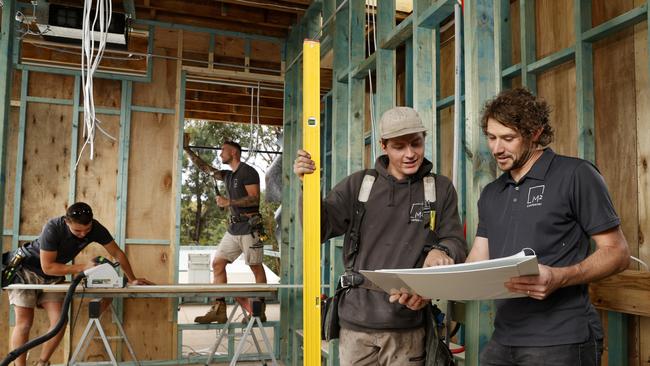Wage growth in reverse firms bets for RBA on hold
A surprise fall in wages growth in the year to June has added to the case for the Reserve Bank to keep rates on hold as workers continue to suffer deep real pay cuts.

A surprise fall in wages growth in the year to June has added to the case for the Reserve Bank to keep rates on hold as workers continue to suffer deep real pay cuts, despite the lowest unemployment in nearly five decades.
As newly released minutes revealed that RBA board members believed “there was a credible path back to the inflation target with the cash rate staying at its present level”, the Australian Bureau of Statistics’ wage price index revealed pay increases decelerated to 3.6 per cent in June, from 3.7 per cent in the year to March.
The wage price index, which measures pay rates for a basket of representative jobs, increased by 0.8 per cent in the three months to June, matching the previous quarter and below the 0.9 per cent rate anticipated by economists.
The data showed only 1.5 per cent of jobs recorded pay increases above the 6 per cent rate of inflation over the year.
Jim Chalmers, however, said there had been “substantial progress” on pay growth, which was running at 2.6 per cent a year ago.
“This is a very welcome outcome today – it shows the Albanese government has been able to get wages moving again.
“We’re seeing inflation moderate at the same time as wages are growing, and on both fronts that’s a good thing,” the Treasurer said, as he flagged the release of Treasury’s intergenerational report on Thursday.
Economists foreshadowed stronger wage increases to come, saying the Fair Work Commission decision to raise the minimum wage by 8.6 per cent and award wages by 5.75 per cent, effective from July 1, would see quarterly wage growth jump to about 1.5 per cent in the three months to September.

Capital Economics economist Abhijit Surya said “the bigger picture is that although wage growth has yet to peak, it is showing few signs of spiralling out of control”.
“Accordingly, we’re sticking to our forecast that the RBA is done tightening policy,” he said.
Annual wage growth for private sector employees was steady at 3.8 per cent in June while public sector pay ticked up to 3.1 per cent, the seasonally adjusted numbers showed.
By industry, the main impetus for private sector pay rises was in construction, where wages lifted by 1.3 per cent in the quarter and by 3.9 per cent in the year.
The fastest annual pace was recorded in the manufacturing sector, with wages lifting by 4.1 per cent, and by 0.8 per cent in the quarter.
RBC Capital chief economist Su-Lin Ong said the latest pay figures “will add to the suite of data giving the RBA some breathing room on the policy front as it looks for reasons to stay on hold”.
The minutes from the RBA’s August 1 board meeting reaffirmed that monetary policymakers were in wait-and-see mode.
The RBA board considered whether to hike the cash rate target to 4.35 per cent or hold it steady at 4.1 per cent, before deciding the case for another pause was “the stronger one”, albeit with the caveat that “it was possible that some further tightening of monetary policy might be required”.
Board members “noted that the recent information on inflation had been encouraging, the economy was expected to grow only slowly over the period ahead and this would help with the further moderation of inflation”.
The next RBA board meeting – which will be Philip Lowe’s last as governor – will be on September 5, and financial markets are not pricing in any chance of a rate rise, according to the ASX.
“Wages growth – as measured by the wage price index – was expected to increase in the second half of 2023 because of ongoing tightness in the labour market, increases in award and minimum wages, and developments in public sector wages,” the minutes noted.
“Importantly, however, the forecasts were predicated on labour productivity growth returning to its pre-pandemic trend over coming years, which would be needed for the expected growth in labour costs to be consistent with the inflation target.”
ABS head of prices statistics Michelle Marquardt said the annual rate of WPI growth remained at levels comparable to those last seen in 2012.
“Compared to a year ago, fewer jobs had wage increases this quarter, however, on average, the increases received were higher,” Ms Marquardt said.
“In particular, the share of jobs which received increases above 3 per cent was the highest for a June quarter since 2012.
For those lucky enough to receive a pay rise for their existing role (the WPI does not reflect promotions or bonuses), the increase was more substantial at 4.5 per cent, the ABS said, versus 3.8 per cent a year earlier.
That said, the share of employees receiving any boost fell to 12 per cent, from 14 per cent in the June quarter of 2022.
Oxford Economics Australia head of forecasting Sean Langcake said wage growth had been stuck at 0.8 per cent for three straight quarters, and this was “a somewhat surprisingly slow pace given the very low level of the unemployment rate” of 3.5 per cent.






To join the conversation, please log in. Don't have an account? Register
Join the conversation, you are commenting as Logout